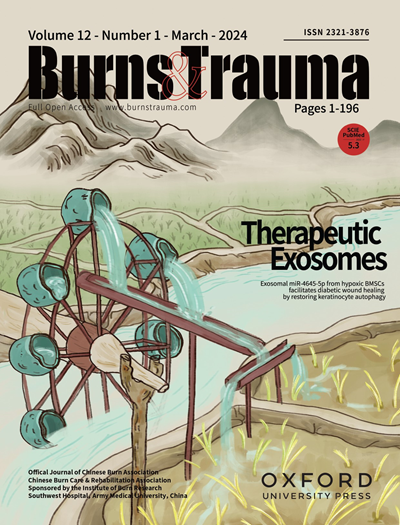The influence of low-frequency vibration on the restoration of the range of knee motion in laboratory animals after immobilization (experimental study)
IF 6.3
1区 医学
Q1 DERMATOLOGY
引用次数: 0
Abstract
Background. The term “joint contractures” is used to describe the loss of passive range of motion of diarthrosis joints, the most common and mobile type of a joint. Measuring passive or active range of motion in a joint with contracture is key to assessing the severity of joint contractures. The purpose of the study: to determine the impact of immobilization on the development of movement limitation in the knee joint of laboratory animals (rats) and to evaluate the possibility of restoring mobility in case of using low-frequency vibration during and after immobilization. Materials and methods. The experimental study was conducted on 30 non-linear white male rats aged 6 months. Immobilization of the pelvic limb was performed at an angle of 140° in the knee joint. The animals were randomly divided into 3 groups: I — immobilization and free restraint after immobilization, II — immobilization and vibration development of the joint after immobilization, III — immobilization and vibration development of the joint during and after immobilization. Vibration development of the immobilized knee joint was performed daily in the mode of 20 Hz with an amplitude of 1.5 mm and a duration of 10 minutes. The range of motion and real contracture were determined as the difference between the measured range of motion and the range of motion before the start of the experiment for each animal individually. Results. It was found that a rapid increase in movement limitation occurs starting from the 2nd week of immobilization. A decrease in the range of motion in rats of the groups I and II under conditions of immobilization occurred the same way. After the end of immobilization, a slow increase in the range of motion was observed in the group I; in the group II, the growth was almost linear and after 4 weeks, the indicator was close to the norm. In the group III, the limitation of the range of motion after immobilization was significantly less; therefore, accordingly, recovery took place already 2 weeks after the removal of the immobilization bandage. Immobilization of the knee joint in rats of groups I and II caused a contracture of 60°, while in the group III, the restrictions did not exceed 25°. And, accordingly, the recovery in the groups with vibration development was rapid; in the group III, a full recovery was achieved, in the group II — a recovery of up to 5° of the residual contracture. In the group I, we observe a residual contracture of almost 35°, which is more than the formed immobilization contracture in the group III. Conclusions. Low-frequency vibration allows reducing the impact of immobilization and significantly accelerate the recovery of mobi-lity (range of motion) of the joint after its completion. If it is impossible to carry out vibrotherapy during the period of immobilization, it should be started as early as possible after immobilization. To date, there are few studies considering the effect of low-frequency vibration on the development of immobilization contractures and their treatment. The obtained data require further research with longer periods of immobilization and those examining immobilization options and modes of vibration impact on the joints.低频振动对实验动物固定后膝关节活动范围恢复的影响(实验研究)
背景。“关节挛缩”一词用于描述腹泻性关节被动活动范围的丧失,腹泻性关节是最常见和活动的关节类型。测量关节挛缩的被动或主动活动范围是评估关节挛缩严重程度的关键。本研究的目的:确定固定对实验动物(大鼠)膝关节运动受限发展的影响,并评估在固定期间和固定后使用低频振动恢复活动能力的可能性。材料和方法。实验研究对象为30只6月龄非线性雄性白种大鼠。骨盆肢体以140°角度在膝关节内固定。将动物随机分为3组:I -固定后的固定和自由约束,II -固定后的固定和关节振动发展,III -固定期间和之后的固定和关节振动发展。固定膝关节的振动发展每天在20 Hz模式下进行,振幅为1.5 mm,持续时间为10分钟。运动范围和实际挛缩是指每只动物的运动范围测量值与实验开始前的运动范围之差。结果。研究发现,从固定后第2周开始,活动受限迅速增加。在固定条件下,I组和II组大鼠的活动范围下降的方式相同。在固定结束后,观察到第一组的活动范围缓慢增加;在第二组,生长几乎是线性的,4周后,指标接近常态。在III组,固定后的活动范围限制明显减少;因此,在拆除固定绷带2周后,患者已经恢复。I组和II组大鼠膝关节固定造成60°挛缩,而III组限制不超过25°。相应地,振动发展组的恢复速度较快;III组完全恢复,II组残余挛缩最多恢复5°。在I组中,我们观察到残余挛缩近35°,这比III组中形成的固定挛缩更多。结论。低频振动可以减少固定的影响,并显着加速关节完成后的活动恢复(运动范围)。如果在固定期间无法进行振动治疗,则应在固定后尽早开始。目前,低频振动对固定挛缩发展及治疗的影响研究较少。获得的数据需要进一步研究更长的固定时间,以及检查固定选项和关节振动影响模式。
本文章由计算机程序翻译,如有差异,请以英文原文为准。
求助全文
约1分钟内获得全文
求助全文
来源期刊

Burns & Trauma
医学-皮肤病学
CiteScore
8.40
自引率
9.40%
发文量
186
审稿时长
6 weeks
期刊介绍:
The first open access journal in the field of burns and trauma injury in the Asia-Pacific region, Burns & Trauma publishes the latest developments in basic, clinical and translational research in the field. With a special focus on prevention, clinical treatment and basic research, the journal welcomes submissions in various aspects of biomaterials, tissue engineering, stem cells, critical care, immunobiology, skin transplantation, and the prevention and regeneration of burns and trauma injuries. With an expert Editorial Board and a team of dedicated scientific editors, the journal enjoys a large readership and is supported by Southwest Hospital, which covers authors'' article processing charges.
 求助内容:
求助内容: 应助结果提醒方式:
应助结果提醒方式:


